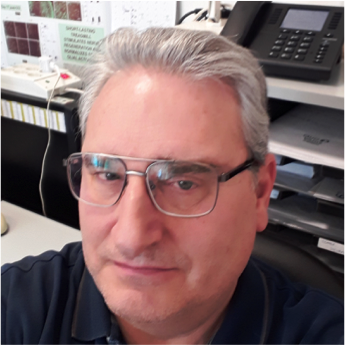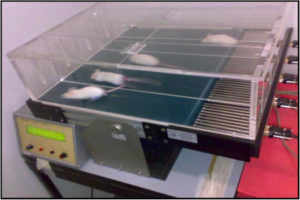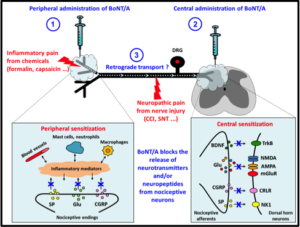
Keywords : Motor Functions, Pain, Botulinum neurotoxins.
 Exercise is a common and necessary component of rehabilitative therapy for functional recovery after traumatic injuries of peripheral nervous system. The onset of neuropathic pain is often a consequence of such traumatic events.
Exercise is a common and necessary component of rehabilitative therapy for functional recovery after traumatic injuries of peripheral nervous system. The onset of neuropathic pain is often a consequence of such traumatic events.
A first aim of my research is to assess what protocol of treadmill exercise is effective both on reducing neuropathic pain symptoms and in accelerating functional recovery after peripheral nerves trauma. The ligature of sciatic nerve in mouse is used as in vivo model of peripheral nerve injury. Preliminary data evidenced that short-lasting treadmill exercise, performed during first week after trauma, counteracts neuropathic pain symptoms, stimulates the regeneration of the injured nerve and accelerates the functional recovery of the lesioned limb [1].  Another potential use of the treadmill exercise concerns the analysis of physical performances of mice suffering from muscular pathologies, with special regards to muscular dystrophies. Under this view, part of my research (actually carried out in collaboration with the research groups of Dr. Caruso and Dr. Moretti from IBBC) is directed to find pharmacological or genetic therapies against these pathological conditions, with the aim of improve the quality of life of the involved subject [2,3].
Another potential use of the treadmill exercise concerns the analysis of physical performances of mice suffering from muscular pathologies, with special regards to muscular dystrophies. Under this view, part of my research (actually carried out in collaboration with the research groups of Dr. Caruso and Dr. Moretti from IBBC) is directed to find pharmacological or genetic therapies against these pathological conditions, with the aim of improve the quality of life of the involved subject [2,3].
A second aim of my research (in collaboration with Dr. Marinelli from IBCC) is directed to study the modulatory effects of the botulinum neurotoxin (BoNTs) on pain. By analysing the in vivo effects of serotype A and B (BoNT/A and /B), we clarified which serotype are more effective and by which mechanism it counteracts pain and facilitates neural regeneration after nerve injury [4,5]. Moreover, a recent discovery of the facilitatory effect of BoNT/A on functional recovery after severe spinal cord injury, opens a new scenario toward a very promising therapy for spinal trauma (European Patent, EP3285800B1).
Education
1984 – Degree in Chemistry at the Department of Physical Chemistry, University of Padova
Positions
- 1985 – Research Fellows at Institute of General Pathology, University of Padova, Italy.
- 1986 – Consulting Assigment at FIDIA Industries, Abano Terme, Italy.
- 1987 – Visiting Scientist at Department of Membrane Research, Weizmann Institute of Science, Rehovot, Israel
- 1988 – CNR Researcher at CNR Unit for the Study of Mitochondrial Physiology, Padova, Italy
- 1997 – CNR Researcher at CNR Unit for the Study of Biomembranes, Padova, Italy
- 2001 – CNR Researcher at CNR Institute of Neuroscience, Section of Padova, Italy
- 2003 – CNR Researcher at CNR Institute of Neuroscience, Section of Roma, Italy
- 2011 – CNR Researcher at CNR Institute of Cell Biology and Neurobiology, Roma, Italy
- 2019 – CNR Researcher at CNR Institute of Biochemistry and Cell Biology, Monterotondo Scalo, Italy.
Honours/Awards:
- 1993 – 1996 Member of the Steering Group of the Italian Bioenergetics and Biomembranes ( GIBB ).
- 2000 – 2001 Member of the Board of Tutors/Supervisors of doctoral students for the XVI° Cycle of the PhD course in Molecular and Cellular Biology and Pathology, Department of Biomedical Sciences, University of Padova.
- 2009 – 2011 Elected Representative of Researchers/Technologists in the Committee of CNR Institute of Neurosciences.
- 2015 – Internal Supervisor for Safety Prevention and protection of Institute of Cell Biology and Neurobiology, Rom
- (2015 – 2019) and of Institute of Biochemistry and Cell Biology, Monterotondo Scalo (2019 – present).
- 2020 – Elected Representative of Researchers/Technologists in the Committee of CNR Institute of Biochemistry and Cell Biology, Monterotondo Scalo.
Patents:
WO2007/017914A2: “Dermonecrotizing protein factors of bacterial origin and related uses in medical field”
WO2016/016119A1: “Compositions and methods for treatment of muscular dystrophy”
EP3285800B1: “A new therapeutic use of the botulinum neurotoxin serotype A”
[1] Cobianchi S, Marinelli S, Florenzano F, Pavone F, Luvisetto S. (2010) Short- but not long-lasting treadmill running reduces allodynia and improves functional recovery after peripheral nerve injury.
Neuroscience. 2010 Jun 16;168(1):273-87. doi: 10.1016/j.neuroscience.2010.03.035.
[2] Strimpakos G, Corbi N, Pisani C, Di Certo MG, Onori A, Luvisetto S, Severini C, Gabanella F, Monaco L, Mattei E, Passananti C. (2014) Novel adeno-associated viral vector delivering the utrophin gene regulator jazz counteracts dystrophic pathology in mdx mice.
J Cell Physiol. 2014 Sep;229(9):1283-91. doi: 10.1002/jcp.24567.
[3] Giannattasio S, Giacovazzo G, Bonato A, Caruso C, Luvisetto S, Coccurello R, Caruso M. (2018) Lack of cyclin D3 induces skeletal muscle fiber-type shifting, increased endurance performance and hypermetabolism. Sci Rep. 2018 Aug 24;8(1):12792. doi: 10.1038/s41598-018-31090-5.
[4] Marinelli S, Vacca V, Ricordy R, Uggenti C, Tata AM, Luvisetto S, Pavone F. (2012) The analgesic effect on neuropathic pain of retrogradely transported botulinum neurotoxin A involves Schwann cells and astrocytes. PLoS One. 2012;7(10):e47977. doi: 10.1371/journal.pone.0047977.
[5] Finocchiaro A, Marinelli S, De Angelis F, Vacca V, Luvisetto S, Pavone F. (2018) Botulinum Toxin B Affects Neuropathic Pain but Not Functional Recovery after Peripheral Nerve Injury in a Mouse Model.
Toxins (Basel). 2018 Mar 18;10(3). pii: E128. doi: 10.3390/toxins10030128.

